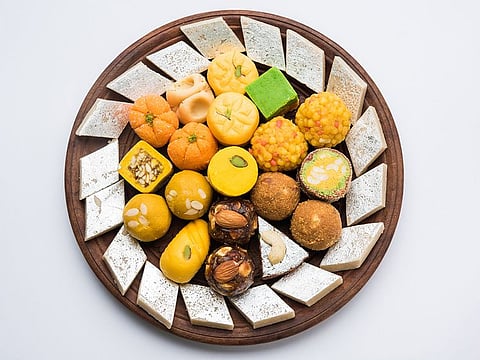Why eating sweets is good for your psyche
People who eat sweets have a sweeter personality, are helpful, and presumably, overweight

As I really love sweets, I immediately said “Yes”, when my wife asked whether she should order ‘Modak”, a dumpling-like sweet, made by our community mompreneur pastry chef.
The sweet is made during the Ganesha festival in India and has a filling made from coconut shavings, jaggery (a coarse dark brown sugar), ghee and poppy seeds.
Several bites into the delicacy gave me a huge sugar rush, but instead of becoming hyper active, I fell into a stupor and needed to nap (and the sleepiness had nothing to do with the addition of poppy seeds).
Indian milk sweets are well, sweet, and even beat the cloying taste of Baklava, the Turkish sweet dunked in syrup and topped with pistachio shavings. After a dainty bite into the latter and you will need strong Turkish coffee to get back to your senses.
Despite the drowsiness effect I still love Indian sweets and would go every Diwali and Eid and stand in a queue at a popular sweet shop in Dubai.
While customers were taking away boxes and boxes of the ‘halwa’, I would wait in line and ask for several samples of the sweets from the harried staff.
Also Read: It is never too late to change
Also Read: Will you change your name for luck?
Also Read: Robbing family jewels is not lucrative
Also Read: How to attract money into your wallet
I even went to the extent of interviewing a ‘halwai’ (a sweet-maker) for my newspaper, because of my love for sweets, and he said that every festival he has to hire extra staff to make the sweets.
Since there are so many festivals in India, the sweet-makers are kept busy through the year, trying to meet the demand from the Indian expatriates in the UAE.
Incidentally, the really expensive sweets are the ones which are covered by a thin layer of silver foil called ‘varq’. I believe silver is pounded into micrometer-thin sheets which is then used to adorn sweets made from almonds and cashew nuts. The silver foil does not have any taste but gives a classy look to the sweet on your dish.
Then sweet-makers tried to keep up with the times and added chocolate to the sweets to give it a more international flavour and came up with things like chocolate ‘burfi’ or chocolate ‘peda’, but they don’t work for me as I want that cloying taste of an Indian sweet that sticks to my palate, and which usually make me go to a dentist.
I also love Pakistani sweets, especially a darkish sweet variety. Pakistanis and Indians also turn healthy vegetables into a sweet; carrot halwa is one such delicacy and is loaded with ghee.
With so many festivals in the subcontinent and with people eating tons of sweets, doctors are kept busy dealing with diabetes among the overweight populace.
The younger generation of Indians and Pakistanis are however, becoming more health conscious (the younger guys go to gyms for workouts, the older ones watch movie stars go to the gyms and doing their workouts on YouTube).
Teaching how to detox
After every fest, newspapers and online portals publish articles that politely show you how to detox.
Since India is a country with a huge diversity, the newspapers are always packed with features on how to lose weight, be it Christmas, Eid, the fest of lights, or the Chinese New Year.
(Incidentally, there is a common myth that Chinese food is easily digestible, but believe me, it can give you acid reflux. Luckily, Chinese sweets such as lychee and ice cream are not really deadly and do not throw your weekly calorie count for a toss).
Some Indian sweets have even got the GI (Geographical Indication) tag to show that they are quality stuff and are ubiquitous in a particular region. One such sweet that has got the tag recently is Sharbhaja, a soft sweet folded into milk skin (‘malai’) and then fried in ghee (clarified butter) and then dipped in sugar syrup.
Still on the topic of sweets, a psychological study done recently shows that people who eat sweets have a sweeter personality and are helpful, and ... presumably, overweight.
Mahmood Saberi is a storyteller and blogger based in Bengaluru, India. Twitter: @mahmood_saberi
Sign up for the Daily Briefing
Get the latest news and updates straight to your inbox







